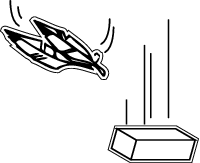Science Projects for Beginners: Why Do Some Objects Fall Faster Than Others?
Why Do Some Objects Fall Faster Than Others?
Gravity is a major player in the study of physical science. It is, of course, the force of gravity that causes objects to fall. One object always exerts a force of attraction on another object. This force of attraction is a pull, like the pull of gravity.
The larger an object is, the greater is the force of its attraction. Consider the fact that the sun, which is much, much larger than the earth, can, even at 90 million miles away, hold the earth and the other eight planets in orbit.
Scientific Surprise
Astronauts who have walked on the moon feel light and weightless because there is very little gravity holding them down. On the other hand, if they were to go to Jupiter, which has much more gravity than the earth, they wouldn't even be able to lift a foot off the ground.
The moon, on the other hand, is much smaller than the earth, and has only about one-sixth of the gravity of the earth.
It was Italian scientist Galileo Galilei who formulated the laws of accelerated motion and free-falling objects. He found that when an object is dropped and falls to the ground it has a falling rate of 9.8 meters per second, squared.
You may wonder, then, why feathers float gently in the breeze instead of falling to the ground quickly, like a brick does.
Well, it's because the air offers much greater resistance to the falling motion of the feather than it does to the brick. The air is actually an upward force of friction, acting against gravity and slowing down the rate at which the feather falls.
The brick, on the other hand, can cut right through the air as if it didn't exist. Galileo discovered that objects that are more dense, or have more mass, fall at a faster rate than less dense objects, due to this air resistance.

If a feather and a brick were dropped together in a vacuum—that is, an area from which all air has been removed—they would fall at the same rate, and hit the ground at the same time.
Understanding these basic facts will help you to be able to answer the question of why some objects fall faster than others.
You can test the rate at which various objects fall, noting both the mass of each object, and how long it takes for it to fall. Be sure to drop all objects from the same height, and be careful to use only objects that can't break. Record all your information in a journal, and chart your results.
Conduct three trials for each object so that you can calculate an average time.

Excerpted from The Complete Idiot's Guide to Science Fair Projects © 2003 by Nancy K. O'Leary and Susan Shelly. All rights reserved including the right of reproduction in whole or in part in any form. Used by arrangement with Alpha Books, a member of Penguin Group (USA) Inc.
To order this book direct from the publisher, visit the Penguin USA website or call 1-800-253-6476. You can also purchase this book at Amazon.com and Barnes & Noble.
